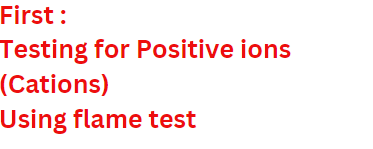Testing for Positive ions (Cations)
Using flame test
The Group 1 elements in the periodic table are known as the Alkali metals.
They include :
lithium, sodium and potassium, .
It is possible to use a flame test to detect the presence of an Alkali metal .
Method:
A cleaned, moistened flame test wire is dipped into a solid sample of the compound after cleaning the write with an Acid solution ( to remove impurities) . It is then placed into the edge of a blue Bunsen flame.
The flame colour produced indicates which alkali metal ion is present in the compound.

Ammonium ions (NH4+) are present in dilute ammonia solution and any ammonium salt, such as ammonium chloride.
Ammonium ions can be identified in a solution by adding
dilute sodium hydroxide solution and gently heating.
If ammonium ions are present, they will be converted to ammonia gas.
Ammonia has a characteristic choking smell.
It also turns damp red litmus paper or damp universal indicator paper blue.
Third : Tests for negative ions (Anions) in solution
1-Testing for carbonate ions
Carbonate ions, CO32- can be detected whether in a solid compound or in solution. An acid, such as dilute hydrochloric acid, is added to the test compound.
Carbon dioxide gas bubbles if carbonate ions are present. Limewater is used to confirm that the gas is carbon dioxide. It turns from clear to milky when carbon dioxide is bubbled through.
2-Testing for sulfate ions
Sulfate ions in solution, SO42-, are detected using barium chloride solution. The test solution is acidified using a few drops of dilute hydrochloric acid, and then a few drops of barium chloride solution are added. A white precipitate of barium sulfate forms if sulfate ions are present.
For example:
barium chloride + sodium sulfate → sodium chloride + barium sulfate
BaCl2(aq) + Na2SO4(aq) → 2NaCl(aq) + BaSO4(s)
The hydrochloric acid is added first to remove any carbonate ions that might be present - they would also produce a white precipitate, giving a false positive result.
Barium nitrate solution can be used instead of barium chloride solution. However, nitric acid is added first to acidify the test solution. Sulfuric acid cannot be used because it contains sulfate ions - these would interfere with the second part of the test.
3-Testing for halide ions
The halogens are the elements in Group 7 of the periodic table. Chlorine, bromine and iodine are halogens. Their ions are called halide ions, eg chloride, Cl-.
Halide ions in solutions are detected using silver nitrate solutions. The test solution is acidified using a few drops of dilute nitric acid, and then a few drops of silver nitrate solution are added. Different coloured silver halide precipitates form, depending on the halide ions present:
- chloride ions give a white precipitate of silver chloride
- bromide ions give a cream precipitate of silver bromide
- iodide ions give a yellow precipitate of silver iodide
For example:
silver nitrate + sodium bromide → sodium nitrate + silver bromide
AgNO3(aq) + NaBr(aq) → NaNO3(aq) + AgBr(s)
One way to remember the colours is to think of ‘milk, cream, butter’ (white, cream, yellow).
The nitric acid is added first to remove any carbonate ions that might be present - they would produce a white precipitate of silver carbonate, giving a false positive result for chloride ions.
4-Testing for nitrate ions (NO3-)
Nitrate ions (NO3-) can be detected by reducing them to ammonia. This is done by:
- adding sodium hydroxide solution, then aluminium powder or foil
- heating strongly
If nitrate ions are present, ammonia gas is given off. This has a characteristic choking smell. It also turns damp red litmus paper or damp universal indicator paper blue.
Summary
Precipitation with aqueous sodium hydroxide
Precipitation with aqueous ammonia
Testing for Gases
Click here for Gases tests required for IGCSE 0620 Latest syllabus
Most Watched Link
































No comments:
Post a Comment